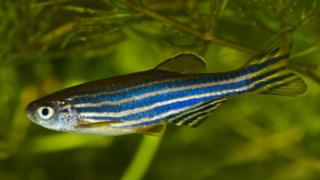 Getty Images
Getty ImagesResearchers in Australia have been studying what happens when hip-hop music is played to fish.
They wanted to know if their young brains can react to unique sounds, tones and different shaped waveforms.
For the experiment, they used baby zebrafish, gently held in a tiny tank, with a miniature sound system attached to it.
The song of choice was ‘U Can’t Touch This’, by rap legend MC Hammer – one of the catchiest tunes of the 90s – just ask your parents!
To enjoy the CBBC Newsround website at its best you will need to have JavaScript turned on.
The team watched what happened to the zebrafish’s brain by scanning it using a special microscope – and the results are very cool.
They could see that the neurons in their tiny brain – the cells that send and receive signals between the brain and the rest of the nervous system – appeared to be reacting to the beat and vocals of the track.
 Getty Images
Getty ImagesDo zebrafish like hip-hop?
DJ and PHD Neuroscientist Rebecca Poulsen, from the Queensland Brain Institute at the University of Queensland in Brisbane, led the study and says that young zebrafish can process audio better than we thought.
She tweeted: “Using Calcium-Imaging we can look at all the fish’s neurons through the brain. We looked at auditory responses and found that larval zebrafish can detect and discriminate between frequencies reaching 2.5kHz, higher than shown before.”
“We found spatially organized clusters of neurons selective for pure tones, white noise, sharp onset sounds, and sounds involving a gradual crescendo. So it seems that larval zebrafish are better at auditory processing than previously thought.” She added.
The research is also helping scientists learn more about how the hearing systems of young fish develop into the more advanced systems of adult fish.
One of the challenges Rebecca faced was keeping the little 3mm-long larval fish still enough to scan their brains, for this they used a form of jelly, that meant it could not move, but could still breath.
And what did MC Hammer himself think of the research? Well, he tweeted to say the research was “Sparking Thoughts”, followed by two explosion emojis.
The research has been published in the journal Current Biology.
from WordPress https://ift.tt/3boSb2X
via IFTTT






No comments:
Post a Comment